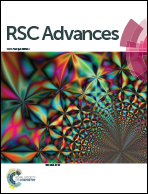Zinc, copper and nickel derivatives of 2-[2-bromoethyliminomethyl]phenol as topoisomerase inhibitors exhibiting anti-proliferative and anti-metastatic properties†
Abstract
Three transition metal derivatives of (2-[2-bromoethyliminomethyl]phenol), M[OC6H4CH![[double bond, length as m-dash]](https://www.rsc.org/images/entities/char_e001.gif) NCH2CH2Br]2 (M is zinc, copper and nickel) along with Ni[OC6H4CH
NCH2CH2Br]2 (M is zinc, copper and nickel) along with Ni[OC6H4CH![[double bond, length as m-dash]](https://www.rsc.org/images/entities/char_e001.gif) NCH2CH2]2(H2O)4·2Br, were found to inhibit topoisomerase I (topo I) activity, induce DNA cleavage and bind to calf thymus DNA. The compounds were found to be cytotoxic when tested against cancer cell lines (A2780, MCF-7, HT29, HepG2, A549, PC3, LNCaP), and were anti-invasive against PC3. The inhibitory strength of the metal complexes was higher than that of the organic compound. The neutral metal complexes were synthesized by the reaction of the metal acetates with the Schiff base ligand whereas the bromide salt was obtained upon recrystallization of the nickel derivative from water. In the crystal structure of this salt, the cyclized Schiff base ligand binds to the nickel atom through its nitrogen donor, the metal atom showing an all-trans octahedral geometry. The metal atom in Cu[OC6H4CH
NCH2CH2]2(H2O)4·2Br, were found to inhibit topoisomerase I (topo I) activity, induce DNA cleavage and bind to calf thymus DNA. The compounds were found to be cytotoxic when tested against cancer cell lines (A2780, MCF-7, HT29, HepG2, A549, PC3, LNCaP), and were anti-invasive against PC3. The inhibitory strength of the metal complexes was higher than that of the organic compound. The neutral metal complexes were synthesized by the reaction of the metal acetates with the Schiff base ligand whereas the bromide salt was obtained upon recrystallization of the nickel derivative from water. In the crystal structure of this salt, the cyclized Schiff base ligand binds to the nickel atom through its nitrogen donor, the metal atom showing an all-trans octahedral geometry. The metal atom in Cu[OC6H4CH![[double bond, length as m-dash]](https://www.rsc.org/images/entities/char_e001.gif) NCH2CH2Br]2 exists in a square-planar environment.
NCH2CH2Br]2 exists in a square-planar environment.
![Graphical abstract: Zinc, copper and nickel derivatives of 2-[2-bromoethyliminomethyl]phenol as topoisomerase inhibitors exhibiting anti-proliferative and anti-metastatic properties](/en/Image/Get?imageInfo.ImageType=GA&imageInfo.ImageIdentifier.ManuscriptID=C4RA09256B&imageInfo.ImageIdentifier.Year=2014)

 Please wait while we load your content...
Please wait while we load your content...